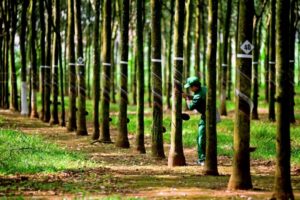Bridgestone to invest U.S.$26.7 million in natural rubber plantations in Southeast Asia
Tokyo, Japan – Bridgestone Corporation (Bridgestone) announced that it has approved plans to strengthen investments in natural rubber plantations it owns in Southeast Asia. Bridgestone will invest U.S.$26.7 million (approximately ¥3.2 billion) in total by 2030. These investments will be targeted at ensuring a sustainable supply of natural rubber, a material used in producing tires. At the same time, the Bridgestone Group will bolster its initiatives to contribute to circular economies and carbon neutrality across the entire value chain through sustainable operation of natural rubber plantations.
These initiatives align with the commitments of “Energy: Committed to the realization of a carbon neutral mobility society”, “Ecology: Committed to advancing sustainable tire technologies and solutions that preserve the environment for future generations” and “Empowerment: Committed to contributing to a society that ensures accessibility and dignity for all” described in a corporate commitment, the “Bridgestone E8 Commitment”.*3
Placing sustainability at the core of management and business, the Bridgestone Group strives to realize its vision of “Toward 2050, Bridgestone continues to provide social and customer value as a sustainable solutions company.” To realize this vision, the Group is accelerating initiatives for contributing to circular economies and carbon neutrality and for advancing its Sustainability Business Framework that ensures the link between sustainability activities and business across the entire value chain, in the “produce and sell,” “use,” and “renew” phases of its Dan-Totsu Products.*4 The Group considers it is important to secure reliable supplies of natural rubber resources so that it can advance sustainable tire technologies and solutions to contribute to safe mobility and movement of people and objects with peace of mind.
The aforementioned investments are intended to enhance productivity of natural rubber plantations Bridgestone owns in Southeast Asia in order to secure sustainable supplies of natural rubber as a renewable material. Bridgestone will make harvest volumes in a given area double in 2035, compared with 2022 projections. Initiatives to this end include introduction of elite trees with stable harvest volume, which are selected by genome analysis technology and ongoing, systematic afforestation for ensuring that natural rubber plantations owned by Bridgetone are properly managed depending on tree age and afforestation cycle. Measures hiring the latest technology that utilizes artificial intelligence (AI) image analysis to diagnose and detect disease in Para rubber trees and the big data to implement optimal plantation for higher yield in natural rubber plantations are also parts of these initiatives. *5
In its long-term environmental vision, the Bridgestone Group has set the long-term environmental vision targeting 2050 and beyond of achieving carbon neutrality and 100% use of sustainable materials. These natural rubber plantation initiatives are part of its efforts to accelerate sustainability initiatives across the value chain for accomplishing these goals. Through sustainable operation of the natural rubber plantations owned by the Group, the Group are currently contributing to the maintenance of approximately 5.9 million tons of CO2 it fixates in trees, and will continue to enhance it through tree planting in devastated areas and expanding elite trees.
Moreover, the operation of owned plantations requires the Bridgestone Group to promote harmony with communities. At owned plantations in Southeast Asia, Bridgestone also provided the access to its clinic to local communities and supported vaccination of COVID-19, while contributed to schooling including donation of personal computers for students to help their studies. Such efforts also include distributing Para rubber tree seedlings to small-scale farmers and teaching them techniques for improving productivity, promoting employment in local communities.

